We Facilitate: 20 facilitation tips to help you be a better facilitator with insight from Martin Gilbraith
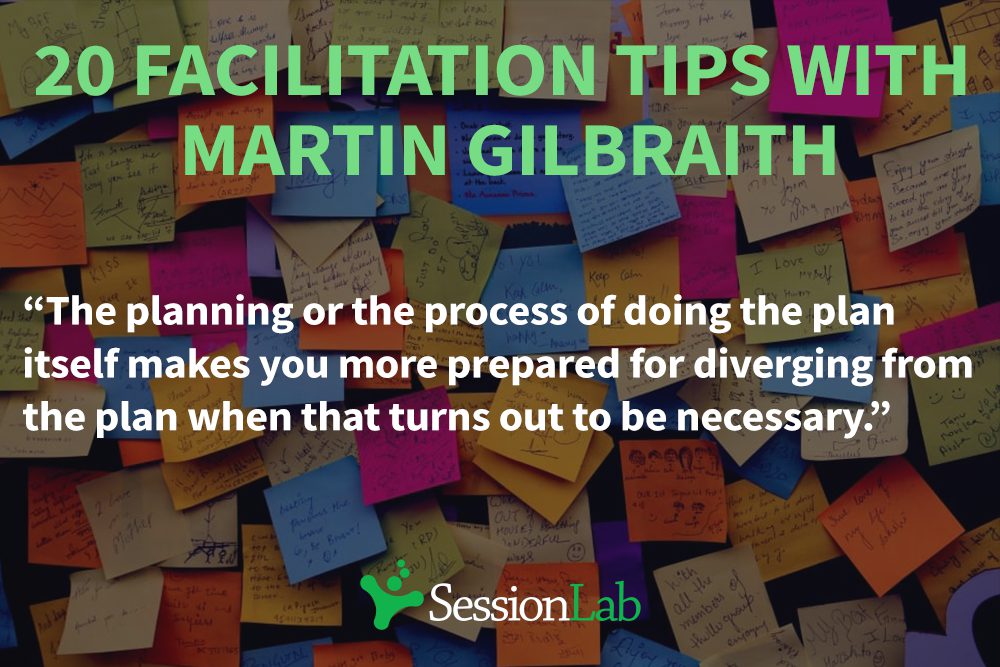
Being a great facilitator is all about listening, learning and growing so that you can guide others towards achieving their goals. But how can you get started as a facilitator, and what resources are there to help you improve your facilitation techniques?
In a series of interviews, we are speaking to expert facilitators and thinkers about their experience of facilitating, some of what they’ve learned, and the challenges they’ve faced.
In this first interview, we spoke to freelance facilitator, trainer and consultant Martin Gilbraith on the subject of facilitation and got to thinking about some of the habits of effective facilitators and some of the insights that stuck out to us. Martin is the head of the England and Wales chapter of the IAF (The International Association of Facilitators) and a facilitator with over 30 years of experience and so we had a lot to talk about! Please do settle down with a cup of tea and read the full interview.
Below, you’ll find 20 facilitation tips that came out of our conversation with Martin which we hope can help improve your facilitation practice. You’ll see a quote from Martin followed by some takeaways and thoughts from us.
We think learning from other practitioners is an important aspect of improving your own practice and learning how others facilitate is valuable whether you are an expert or a beginner. Let’s get started!
- Learn what facilitation is, and what facilitation isn’t
- Know your role
- Do something else first
- Engage with the community
- Be Curious
- Get to know who you’re working with
- Speak to all the key stakeholders…
- …but don’t forget about the rest of the group
- Use technology…
- …but only if the technology suits the purpose
- Plan for all your participants
- Learn how to improvise
- Do the planning but don’t be afraid to change the plan
- Know your strengths and be honest with yourself about areas for improvement
- Keep learning new methods, tools, and techniques…
- … but remember they’ll only take you so far
- Empower your participants to create their own resources
- Build your profile
- Be clear on the expectations of the session
- Be creative
Save time designing your next workshop
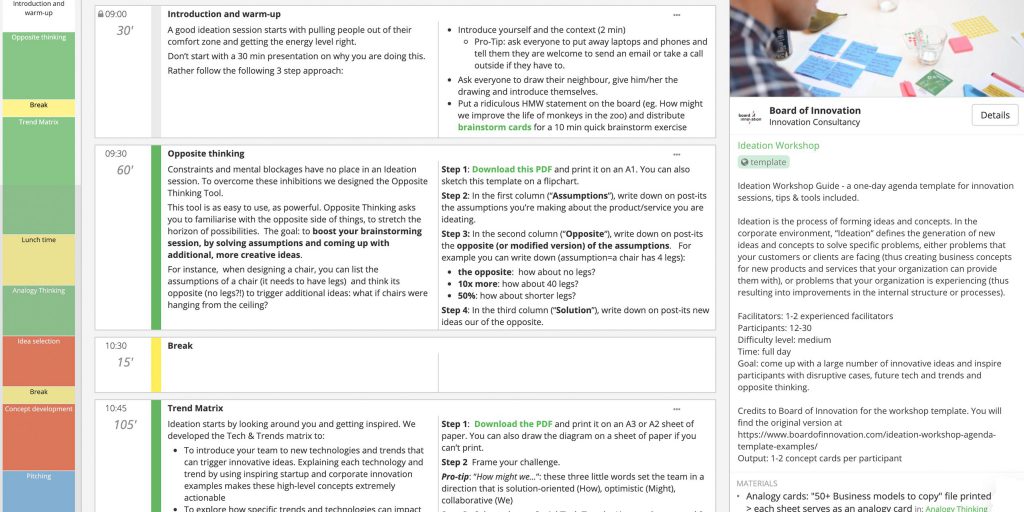
1. Learn what facilitation is and what facilitation isn’t
“Facilitation is a very broad school of practice. It’s not particularly helpful to define it too narrowly. It’s about working in groups rather than individually, it’s about process rather than content, and it’s primarily a leadership role.”
As Martin Gilbraith notes, facilitation can be defined in many ways, though broadly, it centers around the core pillars of leadership processes, group participation, and helping teams invest and participate in their own growth.
From our post on essential skills for facilitators, we define facilitation thusly: “Facilitation is the art of leading people through processes towards agreed-upon objectives in a manner that encourages participation, ownership and creativity by all those involved.”
Understanding the nature of facilitation is the first part of being an effective facilitator and learning the skills you need to facilitate in service of a group and their goals. When you go into a room as a facilitator, that is different than going in as a teacher, a trainer, or a coach. The role of a facilitator is different in that you are helping a group or team think and come up with their own solutions to problems, rather than passing on learning or training.
All of this is to say that there are circumstances in which training, coaching or teaching is absolutely the right approach for a particular project or group. Knowing when facilitation is the appropriate approach is another key part of the role. Remember that whatever you do as a facilitator should be in service of the needs and goals of a group, whatever form that might take.
2. Know your role
“Whether it’s you that thinks the group needs to come to a particular conclusion or whether you’re taking the lead from the client to lead the group to a particular conclusion, either way, it’s not facilitation if you’re trying to lead them to a particular conclusion. Which isn’t to say that you shouldn’t do it. It’s just that you shouldn’t call it facilitation.”
The role of the facilitator is often to help a group engage in a process or dialogue that allows them to move forward, whether that be with regards to a particular project or design initiative. A facilitator should not go into a session with any foregone conclusions.
If you are leading a discursive training session, you may take a different approach that does have more clear conclusions and a more rigid agenda. The key is to know what the purpose of a session is, and what your role in that session is. If you are teaching, teach. If you are facilitating, facilitate. Being clear on what you are doing is integral to ensuring you take the correct approach and stay focused.
A facilitator should lead a group and help them through a process in a way that allows them to discover and draw their own conclusions or solution to a problem, rather than being given a predetermined one.
This is not to say you shouldn’t have a desired outcome or goal in mind. Consider it like this: you have a problem of poor inter-team communication within an organization. You know that you want to improve communication and collaboration and do something to solve the issue of siloing and poor inter-team communication.
A facilitator would work with a group of stakeholders across the organization to help them bring the problems they are facing to light and develop solutions that work for them and improve interoffice communication. The exact nature of the solution is generated by the group with the help of the facilitator. Throughout the facilitation process, the team may find that their problem is simpler or more complex than they thought and as such, any predetermined solution to the problem would not be fit for purpose.
In this scenario, a facilitator is there to guide the participants through the process and facilitate a successful outcome, not to tell the group what to do. Knowing your role in any given workshop, training, coaching or facilitation scenario is integral in providing what the participants and organization needs.
3. Do something else first
“Probably nobody starts their career thinking I want to be a professional facilitator. You really do need to have some experience with the participatory process somehow, from somewhere, in order to be an effective facilitator. The vast majority of professional facilitators come at it as a second career after doing something else that moves them into participatory process.”
Facilitators rarely start their careers as facilitators. Often, people use facilitation techniques or processes while conducting training, workshops or meetings in another role, and later develop and leverage those skills into being a facilitator.
Chances are that if you have been a manager leading a team, have delivered in-house training, or participated in a design-sprint, you have used facilitation techniques by another name.
This experience of working with people, helping them collaborate and participate is a key skill when it comes to being a facilitator. If helping a group achieve a shared goal is something you’re good at and gets you excited, maybe you’re cut out to be a facilitator! Remember that all experiences of group processes – whether you are a leader or participant – are relevant and can be called upon in your future facilitation.
4. Engage with the community
“There are a large number of people I’ve met through IAF in recent years who said I’ve been facilitating for years – in some cases decades – and never met anybody else who does it, never knew there was an association, never knew there were professional standards.
They really appreciated being able to connect with peers and learn and reflect on their own practice in the context of their peers and their peers’ experience, which can be enormously rewarding.”
Facilitation, particularly when working as a freelancer can be isolating or have it’s lonely periods. When not in a room leading a session, facilitators are often designing and planning sessions, learning new methods and techniques, or looking towards landing the next client.
As with many forms of distributed or remote work, having a sense of community and a support network of like-minded professionals is incredibly important.
Reaching out and communicating with other people who facilitate is not only valuable to your wellbeing but your professional practice and development.
Connect with other facilitators and people who do what you do, whether it’s leading workshops for internal teams or as a freelance scrum master. Your peers are often the best source of support and wisdom. Help each other out!
5. Be Curious
“There’s always more to learn and so I’ve gone about learning it.”
At its heart, being a facilitator is about enabling and support people through a process. This involves getting to know those people, their organization, their goals and figuring out the best methods and approaches to help them achieve those goals.
Curiosity is an integral part of being a facilitator. Both in terms of getting to know the team and their objectives, as well as being curious about growing as a facilitator, learning new processes, learning from your peers and participants and continuing to discover new aspects of facilitation.
6. Get to know who you’re working with
“For this group, it was very important to honor the protocol. So there were no post-its, no sticky wall, no toys, none of this kind of stuff. It was basically just a conversation for the best part of a day.
It was really interesting, and they loved it. One of the takeaways from the day was that some of the participants, the health ministers, agreed to make a joint statement on the platform of the main conference of three or four thousand people the next day. ”
There is no single approach to facilitation, and every group has different needs and considerations. What works for a group of internal team members may not work for external stakeholders with a different level of familiarity with your organization or product.
Take the time to get to know the group you will be working with ahead of the session. This might be light touch – a quick survey or email to understand the group objectives and makeup at larger – or much more in-depth. Utilize the knowledge of those people who know the group you’re working with best and defer to them if you need to. If you’re not the expert on a team or working group, speak to the person who is.
The key is to understand enough about your participants to be able to provide the best possible session.
7. Speak to all the key stakeholders…
“Typically I try to make sure I’m not just talking with one person. I try to speak with key stakeholders, particularly the leadership, but also other members of the group.”
Be certain to speak to all the key stakeholders to ensure there is alignment on meeting goals, desired outcomes, and approach. While you may likely have one main point of contact, this may not provide sufficient insight to deliver the session they need.
Bear in mind that you may also want to engage with people who may not be a part of the working session but are nonetheless invested in the session being a success.
Speaking to all key stakeholders prior to a session ties into so many aspects of good facilitation. Planning, designing, and tailoring a great workshop is impossible without knowing the group you will be leading. Engage with all the key stakeholders, ensuring to get the perspective of multiple stakeholders where possible, and really drill down the purpose and objectives of the session.
8. … but don’t forget about the rest of the group.
“I do quite a lot of meetings and events which are for a particular team or department where it’s really quite clear who the group is, and the whole group is going to be there. In that case, usually it’s just about talking to the leadership or the whole group, or a few, a few random representatives of the group to get a sense of what the group needs and how they’re likely to respond.”
Engaging with other members of the group before the meeting can also be useful. Particular with mediations or discussions between management and staff, understanding some of the varied perspectives and positions of those involved can vastly improve the success of any session.
Do keep in mind that this is heavily dependant on the nature of the group, the organization and the purpose of the meeting.
If you are leading a training session, you may not need to liaise with the participants beforehand. If you are mediating a longstanding conflict, speaking to the group ahead of the full discussion is likely necessary. Remember that while the key stakeholders should be your first step in understanding the needs and goals of a group, all the participants likely have something to share that will be useful to the success of the session.
9. Use technology…
“Technology has made a big difference to what’s possible and to what clients and groups are looking for.”
Online tools and technological solutions can solve a lot of problems. Giving remote participants the ability to attend meetings online, using a session planner to collaborate with co-facilitators or using survey tools to gather lots of data swiftly can make the whole process of designing and running a workshop easier and more effective. Increasingly, teams and individuals are growing accustomed to using technology to aid facilitation, collaboration and the planning processes and when working with groups and organizations, it’s advantageous to use what works with them – whether that’s sharing files on Google Drive or Dropbox or facilitating hybrid meetings using web conferencing software.
Using online tools for preparing meetings can make this process of engaging with larger groups of shareholders and group members more effective. Whatever method you choose, ensure that you can clearly communicate with your stakeholders and participants and that you can easily access and record those communications when improving your sessions.
10. …but only if the technology suits the purpose
“I’m very conscious that in order for anything to work, a group needs to be sufficiently familiar with it […] With small groups I tend to avoid digital tools because I tend to find it unnecessary.”
Technology is great. Some technological solutions allow facilitators to achieve things more swiftly, comprehensively and with the advantage of easily leveraging data or facilitating collaboration easily.
But do you need to use technological solutions for ice breaker games in meetings where everyone is in the room? What advantage does using a piece of technology give you? Remember that every new software solution or technological tool you use is something new for participants to learn and potentially get caught up on. Whenever designing an exercise that could use technology, ask whether this is the most efficient and simple method of generating the desired outcomes.
Pen, paper, and post-its are often the quickest and most effective way of allowing people seated at a table to generate ideas. Remember that every meeting, workshop or training session has an objective and that any technology used should be in service of accomplishing that objective in an inclusive and frictionless manner.
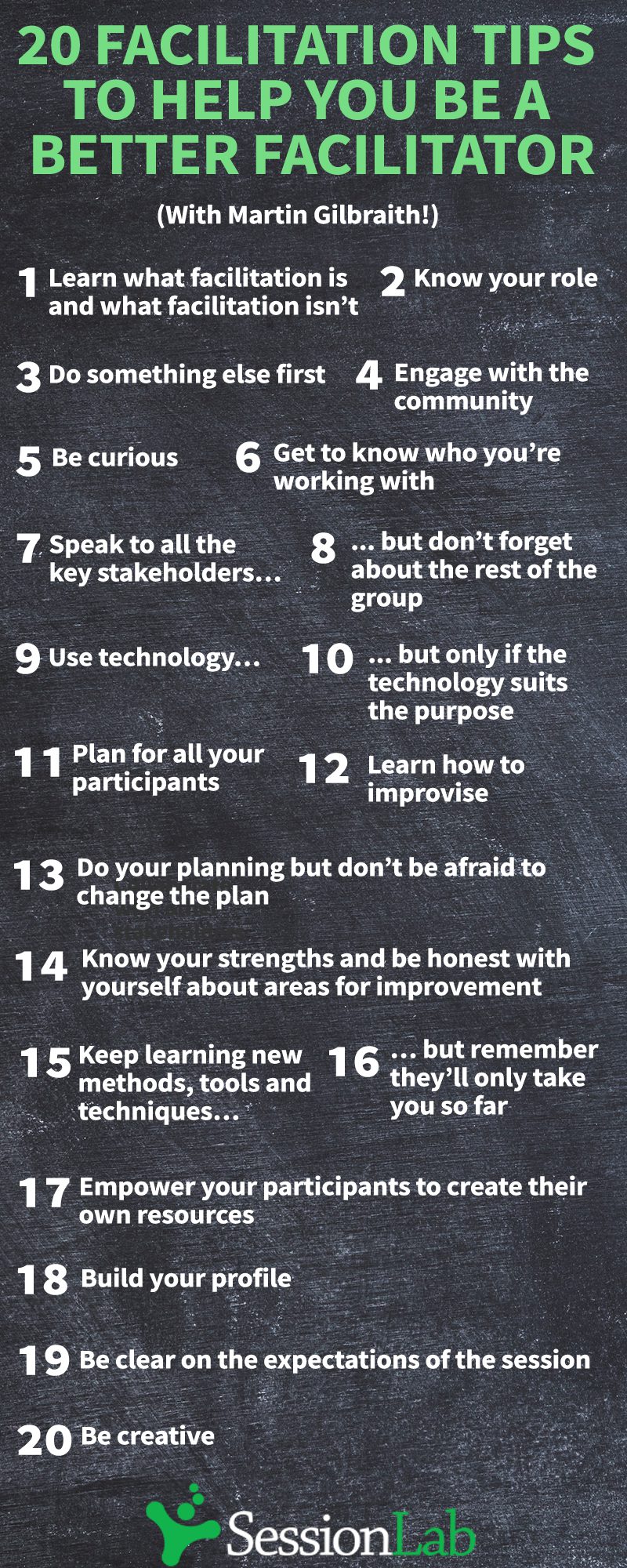
11. Plan for all your participants
“For one of the face to face meetings of this particular Working Group, there were three or four of the 15 people who couldn’t get to Europe because they couldn’t get their visas.So the face to face meeting went ahead without them in Europe for three days, and these remote participants in Asia were intending to participate remotely for the entire three days, eight hours a day!
In order to try and make this possible, the face-to-face facilitator brought me in as a remote co-facilitator so that I could be her partner. I looked after and engaged with the remote participants, and made sure that they were able to engage with what was going on in the room.”
Factoring in the needs of your participants is an important part of facilitation planning. Every session you lead should take into account the needs of the participants on a basic level of design. For example, if you are leading a group training session for 20 people using a new tool, you will need to ensure people have access to that tool and that you design the session with twenty people in mind. But is this broad approach enough?
Understanding the needs of your participants in a more granular, detailed approach is key to ensuring they are a success for everyone involved.
If you have remote participants in a physical meeting, how do you ensure that they get the most out of the session? Do any of your participants have impaired vision or hearing? You will want to set up a hearing aid loop or design additional materials suitable for those people with impaired vision where possible. If you are creating sessions where people are asked to move around the room, is there sufficient access for those people with limited mobility?
The key here is to understand the needs of your group, whether they relate to technology, access, ability or anything else and ensuring that your session is as inclusive as possible. This includes not only speaking to your participants but being sure to listen. Don’t make assumptions and really listen so that you can account for what your participants need and make your sessions inclusive for everyone attending.
12. Learn how to improvise
“You’re always dealing with constraints and the constraints are all almost always unclear, emerging, and often changing. And it’s always a question of, how can we best understand the constraints, manage them, change them if necessary, and work within them and do the best we can within those constraints?”
Improvisation isn’t always a skill we associate with facilitation. A large part of running a successful session is doing adequate research and planning to design a session that is fit for purpose. That said, situations are forever liquid, and by facilitating open conversation, we often find that the needs, objectives, and goals of a group can change as we facilitate. While you can prepare for many eventualities, the reality is that things can emerge in a room that are unexpected.
Improvisation is a skill that allows you to think on your feet, change the parameters or approach of a meeting on the fly and deliver the best possible result for a group in the moment. As Martin notes, applied improvisation is a skill and can be learned. He recommends the Applied Improvisation Network and Rebecca Suthern’s book Nimble: A Coaching Guide for Responsive Facilitation as great places to start.
13. Do the planning but don’t be afraid to change the plan
“The planning or the process of doing the plan itself makes you more prepared for diverging from the plan when that turns out to be necessary.”
To go into a session without sufficient planning is a recipe for disaster. Whenever you facilitate, you should have a complete agenda plan that has been designed with your participants in mind and a clear working plan in place. Go into a meeting with the best plan of action you possibly can, but be open to change if that’s what the group needs.
If your meeting reveals something new that takes precedence or a planned exercise is no longer fit for purpose, be open to changing things up so long as it is in service of the goals of the session and is in service of the group.
14. Know your strengths and be honest with yourself about areas for improvement
“In terms of what not to do, part of what that means is don’t try and do something that you can’t do well.”
Part of working well as a facilitator is about knowing yourself and being honest about your strengths, expertise. There are things you will no doubt do better than others – you might be an agile guru but struggle with high-level executive decision making. When considering a prospective client or meeting, you would have to ask yourself whether that job is right for you and whether you are the right person to facilitate that session.
It might be that you shouldn’t facilitate in that instance, or perhaps you simply need to go away and develop the skills and techniques to be able to do that thing well.
All this is not to say you shouldn’t try new things, but that you should know your skillset and capabilities and lean into those areas where you can be most effective and deliver client value. If there’s something you want to do but don’t believe you can currently do well, that’s a learning opportunity. Self-awareness is an important part of being an effective facilitator and knowing your strengths, weaknesses and where to improve is a surefire way to be happier in your work and ensure your clients and working groups get the best from your sessions.
15. Keep learning new methods, tools, and techniques…
“It’s very supportive and empowering to meet and learn from others and learn with others who are doing it.”
Being a successful facilitator is about continually learning and improving. This can involve being aware of the newest techniques and methods, such as Lego serious play or agile coaching, or reflecting and learning from your peers and your own experience.
One of the best ways to learn new methods, tools and techniques is in connecting with the community of facilitators and professionals, whether that’s through the IAF and its global or local forums or other groups. This might be at a meetup or online or could include investigating the community built SessionLab library of facilitation techniques. There is a large community of experts whose expertise, knowledge and repository of techniques you can draw on in order to improve your own process. Get involved!
16. …but remember they’ll only take you so far
“If you’re lucky, you’ll find training and support and how to design a process, applying and adapting one on all various facilitation methods to help a group achieve an aim. But there’s almost nothing out there in terms of training or literature or support in what to do when it doesn’t turn out as planned and how to prepare for that. And it can be learned.“
New methods, exercises, and approaches are great, and can be a large part of leading a great session, though it’s integral to remember that good facilitation is about process, leadership and allowing the group to generate their desired outcomes. New techniques and methods shouldn’t get in the way of your outcomes or group process, and the fundamentals of facilitation – communication, empathy, and leadership skills – are things you should continue to work on too.
Using fresh new exercises and expanding your toolbox is awesome, though any approach needs to be thoughtfully deployed in order to be successful. Remember that any workshop, meeting or training course has a goal and objective in mind, and any tool or approach must be in service of the process and those goals.
17. Empower your participants to create their own resources
“The way I see it is that the role of the facilitator is to help a group generate and/or work with their own content. To come out with content that they own themselves, that’s theirs. In order to make that happen, a facilitator needs to stay well clear of content and not get involved in content and instead, design and lead a group through a process to help them generate and manage their own content.”
Facilitators are used to leading great workshops and ensuring that the experience of participants in the room is a good one. But how can you ensure the good work done during a session continues afterward and that a team has the resources they need in the future?
Designing a process that helps a team or organization create their own content and resources rather than simply providing them has many benefits. A team tends to be the expert on themselves, their field and their needs: by involving them in the process of content creation, not only will the results be fit for purpose, but they will be more likely to stick.
Giving participants the opportunity to take ownership and responsibility for their content also helps with buy-in and retention and furthermore, you will likely find your participants’ insights and expertise leads to better content overall. Win-win!
18. Build your profile
“All of my clients come from word of mouth, either face to face or online. Face to face is largely people that I have worked with before and then talking with others, or its people I’ve met in various networks come to know me that way or have spoken with others. Online networking through social media and through other online forums is also important. You get to know people that way and they talk with others as well. It’s basically all about getting known.”
Freelance facilitation can be enormously rewarding, but getting work can be a difficult part of the job. Ensuring you have a good number of clients and can pay the bills doing what you love can take time and hard work.
Build a profile as a facilitator and get known for work that you not only are good at but enjoy so that can attract the right clients for you.
Have an online presence – preferably with your own website and social media – and be an active part of the facilitation community, whether that’s online, or in person at conferences and meet-ups. Word of mouth, referrals, and facilitation networks are vital in getting work and improving your process.
19. Be clear on the expectations of the session
“I do work a lot with international groups a lot of them take it for granted that every meeting they ever go to has somebody online, even if it’s not an entirely online meeting. I realized I have to ask clients explicitly upfront: Are you anticipating this to be a hybrid meeting? […] It makes an enormous difference, especially to what the remote participant’s experience is going to be as well.”
Ensuring that everyone involved is clear on what is expected of them in the session is imperative in making sure that everyone is prepared and well-positioned to make it a success.
From the planning stage, get a clear idea of what your client or key stakeholders expect from you as a facilitator and from the meeting. Do they expect people to join online and if so, how do they expect those people to contribute and be present in the session? What is the goal of the session, what are the desired outcomes and how should those be evidenced?
Being clear with the participants beforehand is also important. What expectations do you have in regards to session etiquette, prior planning, and participation? Being clear with everyone involved and ensuring your client is clear on what they want from you will help ensure alignment and avoid frustration. Remember too, to communicate in advance and ensure that everyone who needs to be a part of that conversation is included.
20. Be creative
“One of the things I enjoy most about facilitation is that it’s – especially the design but also a certain amount of improvisation on the day – a very creative process.”
At its best, facilitation is a joyful process of giving a group the tools they need to achieve greater self-knowledge, improve and grow.
Approaching any workshop scenario with a rote, generic approach is unlikely to achieve the best results. Be creative and tailor your methods and exercises to the group you are working with. Can you leverage what you know about them and the organization to make something bespoke and exciting?
Every facilitation scenario is different, and some situations will allow you to be more creative than others. It’s important to remember that if you don’t believe in your approach and aren’t inspired, it can be difficult to get your participants fired up about it. Creativity in design, format or approach can help differentiate you as a facilitator and develop a unique style. As with the previous facilitation tips on continuing to learn and grow throughout your career, be sure to keep being creative and try new things – it will delight your participants and keep things interesting for you too!
In Conclusion
Facilitation is a complex and multifaceted profession that asks for a varied skillset from its practitioners. It can also be enormously rewarding. The feeling you get when you help guide a group through a difficult problem and empower them to create their own solution is hugely gratifying. The above list of facilitation tips is not exhaustive, but hopefully gives you some insight into some of the habits and practices of an expert facilitator. Have any thoughts on the above or want to add your own tips? Please leave a comment below!
Want to hear more from Martin Gilbraith? Look out for our full interview to get more insight and practical advice from a facilitator with over 30 years of experience.
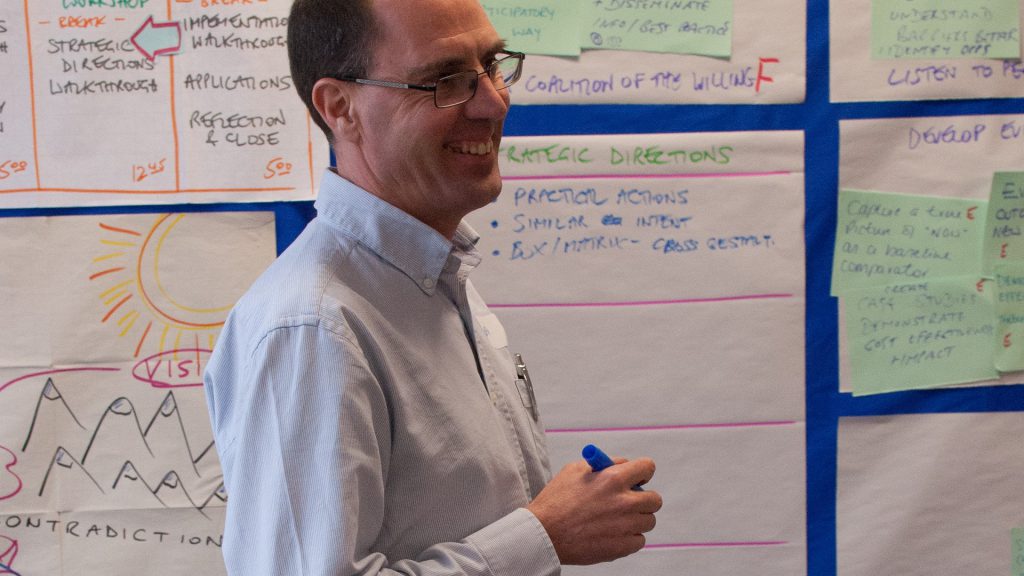
Martin Gilbraith is a IAF Certified Professional Facilitator (CPF), an ICA Certified ToP Facilitator (CTF) and experienced lead trainer and licensed provider of ‘ICA’s ‘ToP’ facilitation training and a Certified Scrum Master (CSM). He has been a facilitator and trainer since 1986 and has been providing facilitation, training and consulting professionally to clients since 1997. He began his career in grassroots community development work in India, Africa and the Middle East, after awakening to his passion and commitment as an international volunteer. Since 1997 he has worked with a wide range of clients in the UK and overseas as a facilitator, trainer and consultant and you can reach him on his website.
Deliver better workshops without the hassle
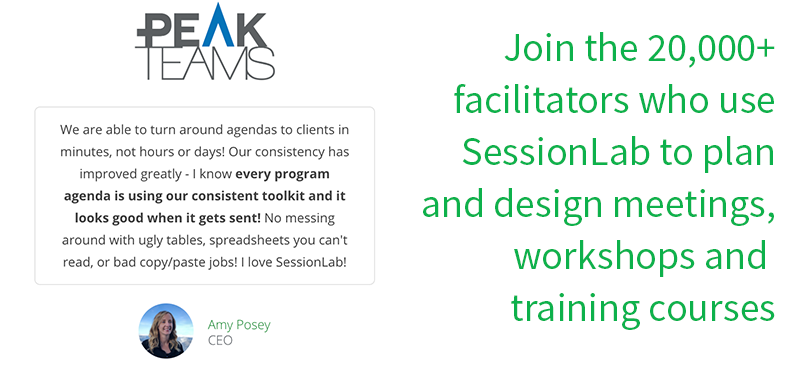
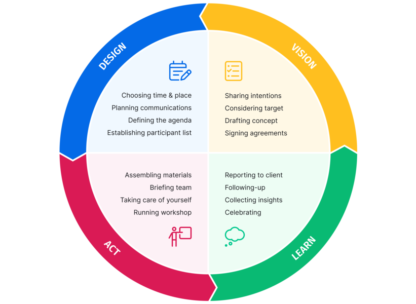
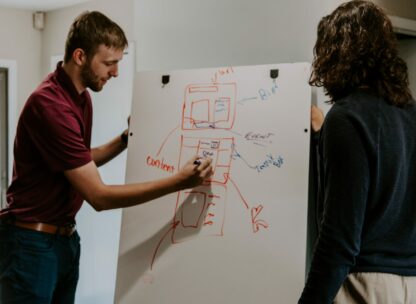

Leave a Comment